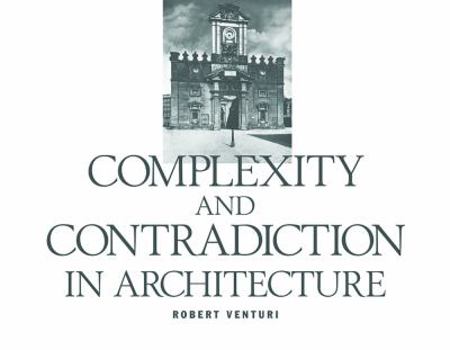Robert Venturi: Complexity and Contradiction in Architecture
Select Format
Select Condition 
Book Overview
First published in 1966, and since translated into 16 languages, this remarkable book has become an essential document of architectural literature. A "gentle manifesto for a nonstraightforward architecture," Venturi's Complexity and Contradiction in Architecture expresses in the most compelling and original terms the postmodern rebellion against the purism of modernism. Three hundred and fifty architectural photographs serve as historical comparisons...
Format:Paperback
Language:English
ISBN:0870702823
ISBN13:9780870702822
Release Date:January 1977
Publisher:Museum of Modern Art
Length:136 Pages
Weight:1.09 lbs.
Dimensions:0.4" x 10.9" x 8.4"
Customer Reviews
4 ratings
A Gentle Manifesto
Published by Thriftbooks.com User , 14 years ago
This book is less a manifesto than it is a very interesting look at how architecture has evolved over the last 2000 years. Venturi evocatively shows that there was no straight line approach to architecture, but rather an ever-changing and ambiguous path that Modernists chose to make short cuts through. In this sense, Venturi really does capture the complexity and contradiction in architecture in that there are many lessons to be learned, making this book as valuable today as it was in 1966 when it first appeared. Being one of the early "gray" architects, Venturi inspired a movement that eventually became characterized as "Post Modern." His early architectural work left a lot to be desired, since it seems less inspired by the many historical examples he favored, like Frank Furness, in this book and more by the banal trends in contemporary architecture at the time, eventually leading to Learning from Las Vegas (1972), where the concept of a building being a "duck," or a decorated shed, emerged. This book's most appealing aspect is that it is immediately accessible. You don't have to be an architect to understand where Venturi is coming from, much less a grad student working on a dissertation. Venturi avoids all that senseless jargon that characterized architectural theory at the time and later came to engulf Po-Mo talk as well.
still essential
Published by Thriftbooks.com User , 17 years ago
"I like complexity and contradiction in architecture." That's how Robert Venturi starts this superb book. No great proclamation. It was an age tired of great proclamations. Instead, Venturi takes us through an impressively learned tour of his favorite things, a grand overview of great architecture, with acute formal analysis of facade and plan composition, sectional variety, and an accumulating realization that complexity is an inevitable force in the tumult of human, urban life. Postmodernism has come and gone, but modernism looks as it does today because of this book.
Still Relevant...
Published by Thriftbooks.com User , 19 years ago
Now that the bottom of postmodernism has actually fallen out and is being dragged along the street by the chains of American capitalism, it's "alright" for students of architecture to return to that misjudged canonical textbook of post-modernism, C+C by Venturi. While not as engaging as his other main work "Learning from Las Vegas", this book still leads the reader into a meticulous analysis of the physical composition of major pieces of architecture, and the composition of the thoughts that made them. After reading it, I found myself unconciously applying it's main dichtomy of complexity and contradiction to much of the architecture around me, if that is any testament to its power.
Gateway towards looking at architecture
Published by Thriftbooks.com User , 20 years ago
I had to read this book for a class specifically regarding Robert Venturi and the postmodernism movement that he became a leading proponent of. However, this book is NOT a manifesto for a postmodern vacabulary- rather, this book looks at all architecture from the Parthenon to the common family home. Let me say that I have read many architectural theory books, but nothing that really inspired me to look at a building and really see what the architect intended like Complexity and Contradiction. This book really focused my attention on the possibilities for great architecture on any level- from museum to treehouse. I feel that anyone with an interest in appreciating architecture should certainly read this book. Because of my studies of Robert Venturi and his contemporaries, I have pursued a degree in architecture and certainly plan to incorperate his ideas and philosophies into my work.






